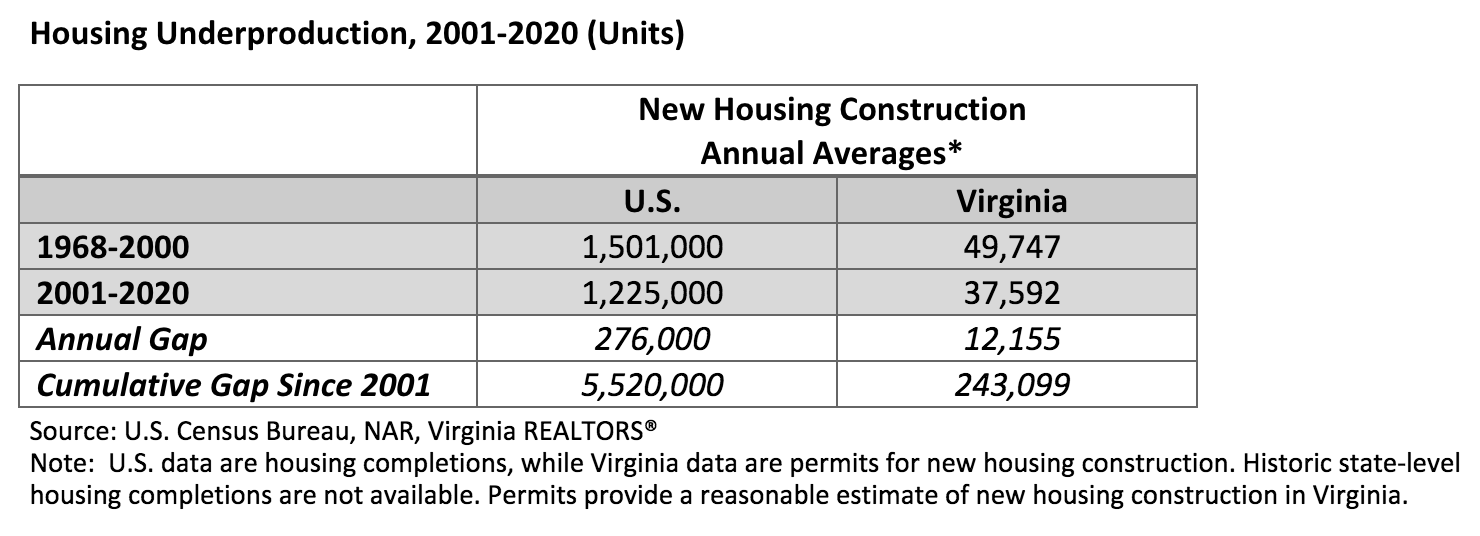We Know We Need More Housing, But How Much?
July 6, 2021
The National Association of REALTORS® has released a report that quantifies the existing housing gap, assesses the consequences of failing to build enough housing, and offers solutions for expanding the housing supply.
According to NAR, the U.S. currently has a housing gap of more than five and a half million units. The study, conducted by Rosen Consulting Group, compared historical trends in new housing construction with more recent trends. If residential construction had kept pace with past trends, we would have 5.52 million more housing units than we do currently.
Between 1968 and 2000, there was an average of 1.5 million new housing completions annually. Between 2001 and 2020, the pace of new construction slowed considerably to 1.225 million housing units each year. Even with the new construction boom in 2004 and 2005, new housing construction has been far off of long-term trends over the past two decades.
This method for quantifying the housing supply-demand gap has some flaws; however, the results are generally consistent with other housing gap studies conducted by Freddie Mac and the Up for Growth Coalition.
Using this same approach, Virginia REALTORS® estimates that there is also a significant housing gap in Virginia. Between 1968 and 2000, there was an average of 49,747 permits issued for the construction of new housing units in the state each year. However, between 2001 and 2020, localities around Virginia permitted the construction for just 37,592 new housing units annually.
Therefore, in Virginia, there is currently an estimated housing gap of 243,099 housing units. To close the gap, there would need to be permits issued for more than 74,000 housing units each year for the next 10 years, which is a level we have not seen since the 1970s and 1980s.

Consequences of Not Enough Housing
The large deficit in housing production has been the primary driver of escalating rents and home prices, driving up affordability challenges in almost every part of Virginia.
In addition, there are other significant economic and fiscal impacts of too little investment in housing. NAR’s study finds that the housing production shortfall over the past two decades has translated into a $4.4 trillion gap in housing investment nationally. Less housing construction led to slower than expected economic growth as measured by gross domestic product.
The consequences of the housing shortfall go beyond economic. Insufficient housing production has led to lower rates of household formation, more young adults living at home with their parents, and significant deterioration of the housing stock in many parts of the country.
Solutions for Encouraging More Housing Production
NAR has promoted several approaches for ramping up new residential construction to close the housing supply-demand gap. Some of these solutions are macro, involving major changes to financial and other institutions. However, others are more locally-oriented. In addition, while some of the strategies recommended by NAR focus specifically on affordable housing, others are targeted at the overall housing supply more broadly.
- Focus federal resources to help address construction capacity challenges such as rising construction costs and labor and materials shortages.
- Create incentives to change local zoning and regulatory environments to increase the quantity of housing.
- Promote conversions of older or underutilized commercial space as housing.
- Expand resources and maximize the potential of existing affordable housing funding programs.
- Develop a coordinated approach to planning, funding, and development of all forms of infrastructure to not only build more housing, but also build better housing and more inclusive neighborhoods.
Brokers and agents can be an important voice for sensible, much-needed solutions to the housing supply challenge in Virginia. For more information about NAR’s report, housing needs in Virginia, or housing production solutions, please contact us.
You might also like…
RESPA & Joint Ventures: What Is Allowed?
By Laura M. Murray - March 6, 2023
We have heard reports that state Attorneys General may be taking an increased interest in certain joint venture arrangements between real estate licensees and settlement companies. Agents may… Read More
DPOR Update: Death or Disability of a Broker
By Laura M. Murray - December 5, 2022
In the 2022 Session, the General Assembly passed a law updating what happens in the event of the death or disability of a sole proprietor or sole broker… Read More
What Do Federal Reserve Rate Hikes Mean for the Housing Market and for Your Business?
By Dr. Lisa Sturtevant - April 4, 2022
In March, the Federal Reserve raised the short-term federal funds rate by 0.25 percentage points. This rate hike was the first time the Fed has raised rates since… Read More